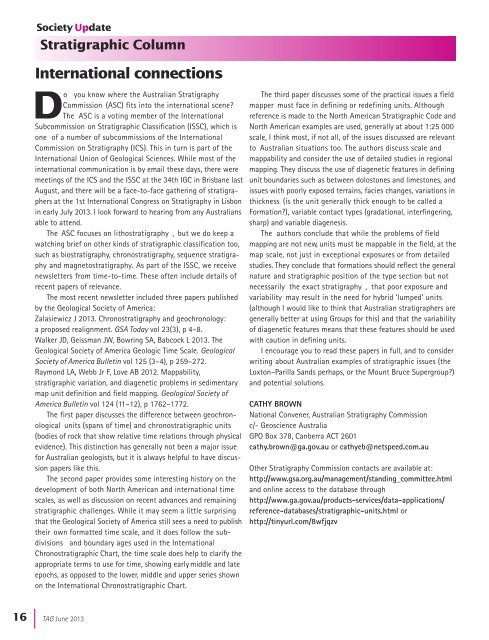TAG 167WEB
TAG 167WEB
TAG 167WEB
You also want an ePaper? Increase the reach of your titles
YUMPU automatically turns print PDFs into web optimized ePapers that Google loves.
Society UpdateStratigraphic ColumnInternational connectionsDo you know where the Australian StratigraphyCommission (ASC) fits into the international scene?The ASC is a voting member of the InternationalSubcommission on Stratigraphic Classification (ISSC), which isone of a number of subcommissions of the InternationalCommission on Stratigraphy (ICS). This in turn is part of theInternational Union of Geological Sciences. While most of theinternational communication is by email these days, there weremeetings of the ICS and the ISSC at the 34th IGC in Brisbane lastAugust, and there will be a face-to-face gathering of stratigraphersat the 1st International Congress on Stratigraphy in Lisbonin early July 2013. I look forward to hearing from any Australiansable to attend.The ASC focuses on lithostratigraphy , but we do keep awatching brief on other kinds of stratigraphic classification too,such as biostratigraphy, chronostratigraphy, sequence stratigraphyand magnetostratigraphy. As part of the ISSC, we receivenewsletters from time-to-time. These often include details ofrecent papers of relevance.The most recent newsletter included three papers publishedby the Geological Society of America:Zalasiewicz J 2013. Chronostratigraphy and geochronology:a proposed realignment. GSA Today vol 23(3), p 4–8.Walker JD, Geissman JW, Bowring SA, Babcock L 2013. TheGeological Society of America Geologic Time Scale. GeologicalSociety of America Bulletin vol 125 (3–4), p 259–272.Raymond LA, Webb Jr F, Love AB 2012. Mappability,stratigraphic variation, and diagenetic problems in sedimentarymap unit definition and field mapping. Geological Society ofAmerica Bulletin vol 124 (11–12), p 1762–1772.The first paper discusses the difference between geochronologicalunits (spans of time) and chronostratigraphic units(bodies of rock that show relative time relations through physicalevidence). This distinction has generally not been a major issuefor Australian geologists, but it is always helpful to have discussionpapers like this.The second paper provides some interesting history on thedevelopment of both North American and international timescales, as well as discussion on recent advances and remainingstratigraphic challenges. While it may seem a little surprisingthat the Geological Society of America still sees a need to publishtheir own formatted time scale, and it does follow the subdivisionsand boundary ages used in the InternationalChronostratigraphic Chart, the time scale does help to clarify theappropriate terms to use for time, showing early, middle and lateepochs, as opposed to the lower, middle and upper series shownon the International Chronostratigraphic Chart.The third paper discusses some of the practical issues a fieldmapper must face in defining or redefining units. Althoughreference is made to the North American Stratigraphic Code andNorth American examples are used, generally at about 1:25 000scale, I think most, if not all, of the issues discussed are relevantto Australian situations too. The authors discuss scale andmappability and consider the use of detailed studies in regionalmapping. They discuss the use of diagenetic features in definingunit boundaries such as between dolostones and limestones, andissues with poorly exposed terrains, facies changes, variations inthickness (is the unit generally thick enough to be called aFormation?), variable contact types (gradational, interfingering,sharp) and variable diagenesis.The authors conclude that while the problems of fieldmapping are not new, units must be mappable in the field, at themap scale, not just in exceptional exposures or from detailedstudies. They conclude that formations should reflect the generalnature and stratigraphic position of the type section but notnecessarily the exact stratigraphy , that poor exposure andvariability may result in the need for hybrid ‘lumped’ units(although I would like to think that Australian stratigraphers aregenerally better at using Groups for this) and that the variabilityof diagenetic features means that these features should be usedwith caution in defining units.I encourage you to read these papers in full, and to considerwriting about Australian examples of stratigraphic issues (theLoxton–Parilla Sands perhaps, or the Mount Bruce Supergroup?)and potential solutions.CATHY BROWNNational Convener, Australian Stratigraphy Commissionc/- Geoscience AustraliaGPO Box 378, Canberra ACT 2601cathy.brown@ga.gov.au or cathyeb@netspeed.com.auOther Stratigraphy Commission contacts are available at:http://www.gsa.org.au/management/standing_committee.htmland online access to the database throughhttp://www.ga.gov.au/products-services/data-applications/reference-databases/stratigraphic-units.html orhttp://tinyurl.com/8wfjqzv16 |<strong>TAG</strong> June 2013


